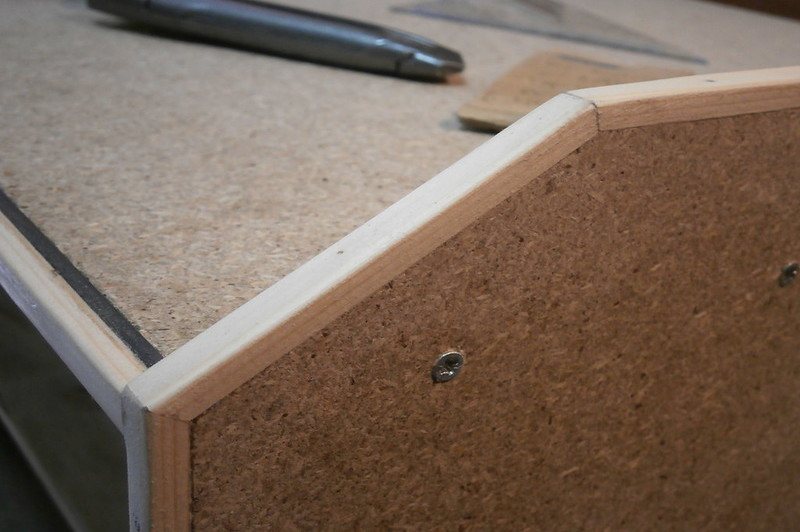If you are on a search to find out how to hide water damaged particle boards, you’ve come to the right place. Particle boards have been among the most used materials for cabinets, furniture, flooring, insulation, and more.
Its low cost and uniformity made it popular and continuously proves why it is an excellent option for construction. However, being wood particles as its main ingredient, it is still vulnerable to water damage.

Thankfully, you don’t have to endure this problem because there are some things that you can do to hide the unpleasant damage of water and excessive moisture.
Signs Of Water Damaged Particle Boards
If you are suspecting possible water damage on your particle boards, here are the signs that you watch out for to confirm the problem.
1. Warping
Warping happens to a wood plank upon the accumulation of too much moisture. The water usually seeps in on the edges while leaving the middle part dry.
This causes an uneven shrinkage and development of stresses around the timber. If you notice some of your particle boards are starting to warp, it is a sign of water damage.
2. Swollen
Swelling and shrinking are common in the wood when its moisture content is constantly changing. It also has something to do with the humidity, and warmer climates are more prone to cause wood to swell.
On the other hand, places with drier air can make the wood shrink due to moisture loss. This can eventually damage the structure of the particleboard and can leave cracks where water can penetrate and foster fungus and unwanted mold growth.
3. Disintegration
As a natural material, wood is prone to disintegration, especially with the combination of moisture and fungus buildup. This happens mainly on boards without proper sealing. The water can enter the particleboard and foster the growth of different fungi, causing the plank to speed up the decay and affecting the nearby materials.
4. Mold
Mold is attracted to anything with constant moisture, so this can also be a sign of water damage on your particle boards. If this is not addressed in the earlier stages, it can lead to a full-blown infestation which can be toxic, especially for people with respiratory problems.
How To Prevent Water Damage On Particle Boards
Particleboards are made from wood chips and sawdust with a binder of either glue or synthetic resin to hold them together. They are low cost—because they have lower durability than other materials.
However, they are still great for cabinetry, furniture building, and home structure as long as they are well installed and sealed correctly to keep the water from seeping in. To ensure a long-lasting life of your particle boards, these are some of the things that you can try to prevent water damage:
Place in an area away from constant moisture
You can avoid rotting, disintegration, and warping particle boards by placing them in areas with less to no moisture. It is not advisable to use particle boards under kitchen and bathroom sinks, backsplashes, laundry areas, and outdoors.
High moisture levels can cause these boards to swell and deform with very little time. It would be best to use them only in places not directly in contact with water sources. This will extend the life of your home fixtures made up of particle boards.
Avoid putting nails and screws into the board
Putting nails and screws into the board can make way for water to penetrate. It can also cause indentations on the surface. The board is made of ground wood chips, so it is easy to lose shape upon structure damage.
Use a powerful sealer
It would be best to seal particle boards properly because this lessens the chance of moisture seeping into its pores and open spaces. You can easily find suitable sealers in supermarkets and online stores. Make sure to seal the whole board, especially the edges, to be protected from water infiltration.
How To Cover Water Damage On Particle Boards
To cover the water damage on particle boards, here are quick and simple steps that you can follow.
Step #1. Dry the damaged area. It is relatively easy to dry and would only take a minimum of 48 hours for the moisture to evaporate.
Waiting for this process to fully finish prevents the damage from worsening and happening again in the future. You can also use various tools such as a hairdryer, dehumidifier, and vacuum.
Step #2. Next, polish the surface of the board using sandpaper. This will minimize the appearance of the damage and remove thin fragments of the wood that might cause splinters. Sanding the surface will also correct the uneven level of the wood due to warping and swelling.
Step #3. You could remove the damaged areas using a knife if sanding did not work enough. Make sure to target the parts with a powdery texture.
Step #4. Add wood fillers if there are existing holes on the board. Wood fillers are easily accessible and also relatively easy to apply.
Use a scraper or a knife to spread the filler into the holes and scrape the excess before it dries out. You can use sandpaper again to level the filler to the board.
Step #5. Apply a waterproof coating to prevent the board from getting wet again. Once the coating is dry, buff the surface to give it a smoother finish. You can choose to leave it as in or add paint according to your preference.
Conclusion
Now that you know how to hide water damaged particle board, it will be much easier to solve it if you’ve encountered the same problem. However, it is necessary to remember that prevention is always better. Investing in a high-quality coat and a proper installation will extend the life of your particle boards.
